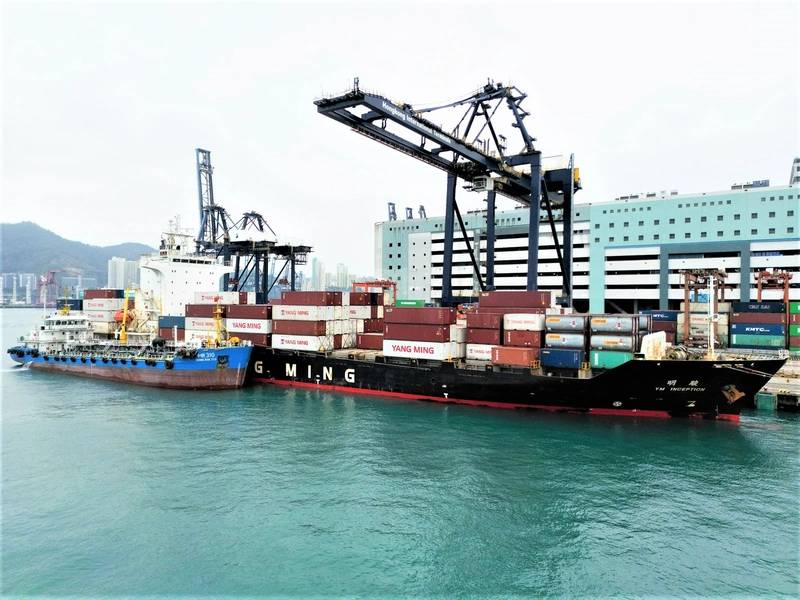Yang Ming Starts Using Biofuel
Yang Ming Starts Using Biofuel MarineLink


Yang Ming Marine Transport Adopts Sustainable Biofuel for Fleet

Yang Ming Marine Transport is adopting sustainable biofuel for its fleet, starting at Hong Kong and Singapore, and will now incorporate biofuel into its annual fuel consumption on an ongoing basis.
Biofuel Adoption
- The adoption of biofuel began with Yang Ming’s 1,805 TEU class container ship, YM Inception, and 6,600 TEU class container ship, YM Masculinity.
- These vessels are currently deployed on the Japan to/from Taiwan, Hong Kong, Vietnam and Thailand service and the Far East to/from Middle East service, respectively.
Collaboration with Energy Providers
- In collaboration with energy providers Chimbusco Pan Nation Petro-Chemical and KPI OceanConnect, both vessels have been bunkered with B24 biofuel.
- The biofuel is certified by the International Sustainability & Carbon Certification (ISCC) and comprises a blend of Fatty Acid Methyl Ester (FAME) and Very Low Sulfur Fuel Oil (VLSFO).
Reduction in Carbon Emissions
By embracing the biofuel, Yang Ming can achieve a substantial reduction of approximately 20% in carbon emissions compared to conventional fuel oil.
Yang Ming’s Chairman’s Statement
Yang Ming Chairman Cheng Cheng-Mount stated: “Confronted with future regulatory requirements and the challenges of decarbonization, the adoption of biofuel signifies a significant milestone for Yang Ming as it transitions towards achieving net-zero carbon emissions. Despite the associated higher costs, Yang Ming plans to gradually expand the use of biofuel in 2024, continuing research and investment in new alternative energy sources to realize a 20% reduction in total carbon emissions by 2030 compared to the levels in 2018.”
Additional Energy-Saving Measures
In addition to the integration of biofuel, Yang Ming has already implemented a range of energy-saving and emission reduction measures on its fleet:
- Retrofitting existing vessels for enhanced energy efficiency
- Utilizing big data analysis to optimize vessel performance
- Implementing route optimization strategies
Newly-Built LNG Dual-Fuel Container Ships
The company expects the delivery of five newly-built 15,500 TEU LNG dual-fuel container ships starting in 2026.
SDGs, Targets, and Indicators
-
SDG 7: Affordable and Clean Energy
- Target 7.2: Increase substantially the share of renewable energy in the global energy mix
- Indicator 7.2.1: Renewable energy share in the total final energy consumption
-
SDG 13: Climate Action
- Target 13.2: Integrate climate change measures into national policies, strategies, and planning
- Indicator 13.2.1: Number of countries that have integrated mitigation, adaptation, impact reduction, and early warning into primary, secondary, and tertiary curricula
- Indicator 13.2.2: Number of countries that have communicated the strengthening of institutional, systemic, and individual capacity-building to implement adaptation, mitigation, and technology transfer
-
SDG 14: Life Below Water
- Target 14.1: By 2025, prevent and significantly reduce marine pollution of all kinds, particularly from land-based activities, including marine debris and nutrient pollution
- Indicator 14.1.1: Index of coastal eutrophication and floating plastic debris density
-
SDG 15: Life on Land
- Target 15.5: Take urgent and significant action to reduce the degradation of natural habitats, halt the loss of biodiversity, and protect and prevent the extinction of threatened species
- Indicator 15.5.1: Red List Index
Analysis
The issues highlighted in the article are connected to several Sustainable Development Goals (SDGs) and their respective targets and indicators.
1. SDG 7: Affordable and Clean Energy
The adoption of biofuel by Yang Ming Marine Transport contributes to SDG 7, which aims to ensure access to affordable, reliable, sustainable, and modern energy for all. By incorporating biofuel into its fleet, Yang Ming is increasing the share of renewable energy in the global energy mix.
2. SDG 13: Climate Action
The use of biofuel by Yang Ming also aligns with SDG 13, which focuses on taking urgent action to combat climate change and its impacts. By reducing carbon emissions by approximately 20% compared to conventional fuel oil, Yang Ming is contributing to the target of integrating climate change measures into national policies, strategies, and planning.
3. SDG 14: Life Below Water
The article mentions that Yang Ming has implemented energy-saving and emission reduction measures on its fleet, including retrofitting existing vessels for enhanced energy efficiency. These measures contribute to SDG 14, which aims to conserve and sustainably use the oceans, seas, and marine resources. By reducing emissions and improving energy efficiency, Yang Ming helps prevent marine pollution from land-based activities.
4. SDG 15: Life on Land
Yang Ming’s commitment to reducing carbon emissions and exploring alternative energy sources aligns with SDG 15, which focuses on protecting, restoring, and promoting sustainable use of terrestrial ecosystems. By taking action to reduce the degradation of natural habitats and halt biodiversity loss, Yang Ming contributes to this goal.
Table: SDGs, Targets, and Indicators
| SDGs | Targets | Indicators | |
|---|---|---|---|
| SDG 7: Affordable and Clean Energy | Target 7.2: Increase substantially the share of renewable energy in the global energy mix | Indicator 7.2.1: Renewable energy share in the total final energy consumption | |
| SDG 13: Climate Action | Target 13.2: Integrate climate change measures into national policies, strategies, and planning | Indicator 13.2.1: Number of countries that have integrated mitigation, adaptation, impact reduction, and early warning into primary, secondary, and tertiary curricula | Indicator 13.2.2: Number of countries that have communicated the strengthening of institutional, systemic, and individual capacity-building to implement adaptation, mitigation, and technology transfer |
| SDG 14: Life Below Water | Target 14.1: By 2025, prevent and significantly reduce marine pollution of all kinds, particularly from land-based activities, including marine debris and nutrient pollution | Indicator 14.1.1: Index of coastal eutrophication and floating plastic debris density | |
| SDG 15: Life on Land | Target 15.5: Take urgent and significant action to reduce the degradation of natural habitats, halt the loss of biodiversity, and protect and prevent the extinction of threatened species | Indicator 15.5.1: Red List Index |
Behold! This splendid article springs forth from the wellspring of knowledge, shaped by a wondrous proprietary AI technology that delved into a vast ocean of data, illuminating the path towards the Sustainable Development Goals. Remember that all rights are reserved by SDG Investors LLC, empowering us to champion progress together.
Source: marinelink.com

Join us, as fellow seekers of change, on a transformative journey at https://sdgtalks.ai/welcome, where you can become a member and actively contribute to shaping a brighter future.







